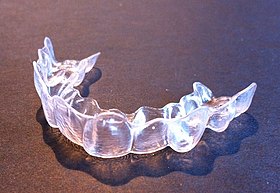Invisalign
| Clear aligners | |
|---|---|
| Intervention | |

An Invisalign aligner
|
Clear aligners, also known as clear-aligner treatment, are orthodontic devices that uses incremental transparent aligners to adjust teeth as an alternative to dental braces. They are sold under at least five brand names.
A 2014 systematic review concluded that there is insufficient evidence to determine the effectiveness of these therapies. Opinion is that they are effective for moderate crowding of the front teeth, but are less effective than conventional braces for several other issues and are not recommended for children. In particular they are indicated for "mild to moderate crowding (1–6 mm) and mild to moderate spacing (1–6 mm)", in cases where there are no discrepancies of the jawbone. They are also indicated for patients who have experienced a relapse after fixed orthodontic treatment. Despite patent infringement litigation, no manufacturer has obtained an injunction against another manufacturer.
Clear-aligner treatment involves an orthodontist or dentist, or with home-based systems, the person themselves, taking a mold of the patient's teeth, which is used to create a digital tooth scan. The computerized model suggests stages between the current and desired teeth positions, and aligners are created for each stage. Each aligner is worn for 20 hours a day for two weeks. These slowly move the teeth into the position agreed between the orthodonist/dentist and the patient. The average treatment time is 13.5 months.
A 2014 systematic review concluded that there is insufficient evidence to determine the effectiveness of these clear aligners. Opinion is that they are likely useful for moderate front-teeth crowding. In those with teeth that are too far forward or backward, or rotated in the socket, the aligners are likely not as effective as conventional braces. More cases of relapse of the anterior teeth have been found with clear aligners compared with conventional braces. A 2013 Cochrane review found no high-quality evidence with respect to the management of the recurrence of lower-front-teeth misalignment following treatment.
Clear aligners are more noticeable than lingual braces, but are probably more comfortable. They can be removed, which makes cleaning of the teeth easier, and they are faster for the dentist to apply.
Treatment begins with taking x-ray, photographs, a bite registration, and polyvinyl siloxane impressions of the person's teeth and gums. The dentist/orthodontist completes a written evaluation that includes diagnosis and treatment plan. Dental impressions are scanned in order to create a digital 3D representation of the teeth. Technicians move the teeth to the desired location with the program Treat, which creates the stages between the current and desired teeth positions. Anywhere from six to forty-eight aligners may be needed. Each aligner moves teeth .25 to .33 millimeters.
...
Wikipedia
